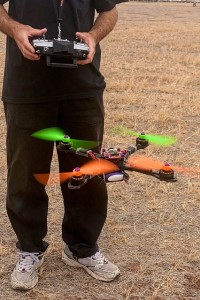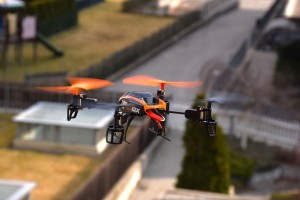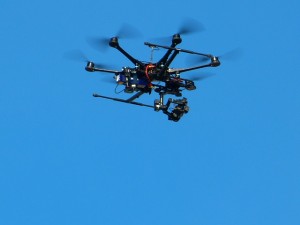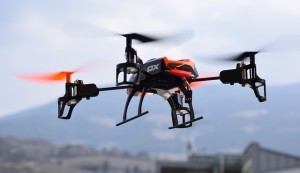 At their simplest, drones are defined as unmanned aircraft, which are used for a variety of purposes by the military, police, firefighters, civilian sectors and hobbyists. While some very advanced drones are capable of having their missions programed into them, the vast majority are still reliant on human pilots, who control the drone from a remote location. Hobby drones rarely get farther than 400 feet from their pilot, while military pilots can control their drones from thousands of miles away.
At their simplest, drones are defined as unmanned aircraft, which are used for a variety of purposes by the military, police, firefighters, civilian sectors and hobbyists. While some very advanced drones are capable of having their missions programed into them, the vast majority are still reliant on human pilots, who control the drone from a remote location. Hobby drones rarely get farther than 400 feet from their pilot, while military pilots can control their drones from thousands of miles away.
Pilots have a controller which communicate with the drone via radio waves. These controllers are vital for the launching, landing, and navigation of drones. The type of controller is varied. It can be a device that looks similar to a game-pad, but since Wi-Fi is a type of radio wave, even smartphones and tablets can be used to control drones.
Even though they do require pilots, many drones have built in features that allow them a level of autonomy, with the ability to do such things as fly, hover, and navigate their way home without the input of a pilot. They manage to be able to keep themselves aloft and navigating without continuous human input due to such technologies as gyroscopes, which allow the drone to collect sensory data from its environment. Read the rest of this entry
With the increasing presence of drones, quadcopters, and other small, unmanned aircraft in the world, both for professional and personal use, it is important to know the jargon around these aircraft. Unmanned aircraft are used in many different situations, from military reconnaissance, police surveillance, firefighting investigation, inspecting pipelines and power lines, search and rescue missions, and increasingly as a recreational past time for civilians and for commercial purposes. Read the rest of this entry
 Drones are often tied to the military in the minds of today’s public, but the civilian uses of such equipment are steadily growing. A civilian drone is defined as a unmanned, flying, small aircraft that can be controlled via a radio control or by programming, and capable of completing a flight without a present human element. They do, however, still have pilots as typically civilian drones require the real time control and adjustments made by human controllers. They are limited by a weight payload, and the most common use is in video feed.
Drones are often tied to the military in the minds of today’s public, but the civilian uses of such equipment are steadily growing. A civilian drone is defined as a unmanned, flying, small aircraft that can be controlled via a radio control or by programming, and capable of completing a flight without a present human element. They do, however, still have pilots as typically civilian drones require the real time control and adjustments made by human controllers. They are limited by a weight payload, and the most common use is in video feed.
Civilian uses of drones are far reaching. It is important to define “civilian,” however. In the most basic terms, a civilian is not a member of an armed force, and is not taking part in armed combat. However, as far as civilian drone projects are concerned, even police surveillance and firefighter uses of drones are not considered to be civilian, though these are important non-military uses for drones in the present day. Read the rest of this entry

Quadcopter photography is used in many different purposes. It is used for military and police surveillance. Firefighters employ it in situations that would be hazardous to manned aircraft. The use is also growing in the civilian commercial and private sectors.
Cameras can be attached to the aircrafts and some quadcopters have equipment built in that can film in high definition.
Videographers now know that using a quadcopter for aerial photography opens up a whole world of new options for both commercial and personal uses. Quadcopters, a type of unmanned aerial vehicle, are maneuverable enough to allow for photos and videos that have been impossible before.
Read the rest of this entry
 With the increasing affordability of unmanned or remotely controlled aircraft, quadcopter flight and photography is a great hobby for enthusiasts to take part in. However, since these are still expensive pieces of equipment, and cause serious harm to property and human bodies, there are some very important safety rules to keep in mind when you are flying a quadcopter.
With the increasing affordability of unmanned or remotely controlled aircraft, quadcopter flight and photography is a great hobby for enthusiasts to take part in. However, since these are still expensive pieces of equipment, and cause serious harm to property and human bodies, there are some very important safety rules to keep in mind when you are flying a quadcopter.
The first rule that must always be adhered to is to keep the aircraft in your direct line of sight. If you can’t see your quadcopter, you can’t see where it is going and what obstacles are in its way. As long as you can see it, you can respond quickly to it movements, and there is less chance that you will lose your radio connection between your controller and your aircraft. This significantly reduces the chances that you will lose control of your aircraft. Read the rest of this entry
 At their simplest, drones are defined as unmanned aircraft, which are used for a variety of purposes by the military, police, firefighters, civilian sectors and hobbyists. While some very advanced drones are capable of having their missions programed into them, the vast majority are still reliant on human pilots, who control the drone from a remote location. Hobby drones rarely get farther than 400 feet from their pilot, while military pilots can control their drones from thousands of miles away.
At their simplest, drones are defined as unmanned aircraft, which are used for a variety of purposes by the military, police, firefighters, civilian sectors and hobbyists. While some very advanced drones are capable of having their missions programed into them, the vast majority are still reliant on human pilots, who control the drone from a remote location. Hobby drones rarely get farther than 400 feet from their pilot, while military pilots can control their drones from thousands of miles away. Drones are often tied to the military in the minds of today’s public, but the civilian uses of such equipment are steadily growing. A civilian drone is defined as a unmanned, flying, small aircraft that can be controlled via a radio control or by programming, and capable of completing a flight without a present human element. They do, however, still have pilots as typically civilian drones require the real time control and adjustments made by human controllers. They are limited by a weight payload, and the most common use is in video feed.
Drones are often tied to the military in the minds of today’s public, but the civilian uses of such equipment are steadily growing. A civilian drone is defined as a unmanned, flying, small aircraft that can be controlled via a radio control or by programming, and capable of completing a flight without a present human element. They do, however, still have pilots as typically civilian drones require the real time control and adjustments made by human controllers. They are limited by a weight payload, and the most common use is in video feed.
 With the increasing affordability of unmanned or remotely controlled aircraft, quadcopter flight and photography is a great hobby for enthusiasts to take part in. However, since these are still expensive pieces of equipment, and cause serious harm to property and human bodies, there are some very important safety rules to keep in mind when you are flying a quadcopter.
With the increasing affordability of unmanned or remotely controlled aircraft, quadcopter flight and photography is a great hobby for enthusiasts to take part in. However, since these are still expensive pieces of equipment, and cause serious harm to property and human bodies, there are some very important safety rules to keep in mind when you are flying a quadcopter.